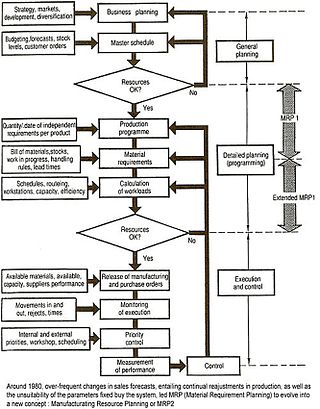Related Research Articles

Enterprise resource planning (ERP) is the integrated management of main business processes, often in real time and mediated by software and technology. ERP is usually referred to as a category of business management software—typically a suite of integrated applications—that an organization can use to collect, store, manage and interpret data from many business activities. ERP systems can be local based or cloud-based. Cloud-based applications have grown in recent years due to information being readily available from any location with Internet access. Traditional on-premise ERP systems are now considered legacy technology.
A management information system (MIS) is an information system used for decision-making, and for the coordination, control, analysis, and visualization of information in an organization. The study of the management information systems involves people, processes and technology in an organizational context.

Data management comprises all disciplines related to handling data as a valuable resource.

Manufacturingresource planning is defined as a method for the effective planning of all resources of a manufacturing company. Ideally, it addresses operational planning in units, financial planning, and has a simulation capability to answer "what-if" questions and is an extension of closed-loop MRP.
Enterprise architecture (EA) is a business function concerned with the structures and behaviors of a business, especially business roles and processes that create and use business data. An Enterprise Architect is at the top level of the architect hierarchy. This means they have more responsibilities than solutions architects. While solutions architects focus on their solution, an enterprise architect focuses on the overview of the whole organization. An enterprise architect leads over many solutions architects and business functions. By international consensus, Enterprise Architecture has been defined as "a well-defined practice for conducting enterprise analysis, design, planning, and implementation, using a comprehensive approach at all times, for the successful development and execution of strategy. Enterprise architecture applies architecture principles and practices to guide organizations through the business, information, process, and technology changes necessary to execute their strategies. These practices utilize the various aspects of an enterprise to identify, motivate, and achieve these changes."
A warehouse management system (WMS) is a set of policies and processes intended to organise the work of a warehouse or distribution centre, and ensure that such a facility can operate efficiently and meet its objectives.
Enterprise software, also known as enterprise application software (EAS), is computer software used to satisfy the needs of an organization rather than individual users. Such organizations include businesses, schools, interest-based user groups, clubs, charities, and governments. Enterprise software is an integral part of a (computer-based) information system; a collection of such software is called an enterprise system. These systems handle a number of operations in an organization to enhance the business and management reporting tasks. The systems must process the information at a relatively high speed and can be deployed across a variety of networks.
Maris Martinsons is a professor of management currently associated with the City University of Hong Kong, the Stockholm School of Economics, and the University of Toronto. He received his B.A.Sc. in engineering science and MBA from the University of Toronto, and a PhD in industrial and business studies from the University of Warwick. He has served as editor for the following scholarly journals: IEEE Transactions on Engineering Management, the Journal of Applied Management Studies, the Journal of Information Technology Management, the Journal of Management Systems, and the Communications of the ACM.

SAP ERP is an enterprise resource planning software developed by the German company SAP SE. SAP ERP incorporates the key business functions of an organization. The latest version of SAP ERP (V.6.0) was made available in 2006. The most recent SAP enhancement package 8 for SAP ERP 6.0 was released in 2016. It is now considered legacy technology, having been superseded by SAP S/4HANA.
Enterprise social software, comprises social software as used in "enterprise" (business/commercial) contexts. It includes social and networked modifications to corporate intranets and other classic software platforms used by large companies to organize their communication. In contrast to traditional enterprise software, which imposes structure prior to use, enterprise social software tends to encourage use prior to providing structure.
Outsourcing relationship management (ORM) is the business discipline widely adopted by companies and public institutions to manage one or more external service providers as part of an outsourcing strategy. ORM is a broadly used term that encompasses elements of organizational structure, management strategy and information technology infrastructure.
Manufacturing execution systems (MES) are computerized systems used in manufacturing to track and document the transformation of raw materials to finished goods. MES provides information that helps manufacturing decision-makers understand how current conditions on the plant floor can be optimized to improve production output. MES works as real-time monitoring system to enable the control of multiple elements of the production process.
An enterprise appliance transaction module (EATM) is a device, typically used in the manufacturing automation marketplace, for the transfer of plant floor equipment and product status to manufacturing execution systems (MES), enterprise resource planning (ERP) systems and the like.
An enterprise planning system covers the methods of planning for the internal and external factors that affect an enterprise.
The Digital Firm is a kind of organization that has enabled core business relationships through digital networks In these digital networks are supported by enterprise class technology platforms that have been leveraged within an organization to support critical business functions and services. Some examples of these technology platforms are Customer Relationship Management (CRM), Supply Chain Management (SCM), Enterprise Resource Planning (ERP), Knowledge Management System (KMS), Enterprise Content Management (ECM), and Warehouse Management System (WMS) among others. The purpose of these technology platforms is to digitally enable seamless integration and information exchange within the organization to employees and outside the organization to customers, suppliers, and other business partners.
The goal of content-oriented workflow models is to articulate workflow progression by the presence of content units . Most content-oriented workflow approaches provide a life-cycle model for content units, such that workflow progression can be qualified by conditions on the state of the units. Most approaches are research and work in progress and the content models and life-cycle models are more or less formalized.
Johannes Adrianus Petrus (Jan) Hoogervorst is a Dutch organizational theorist, business executive, management consultant, and Professor Enterprise Governance and Enterprise Engineering at the University of Antwerp, known for his work in the field of enterprise engineering.

The BIT – Business Information Technology Institute in Mannheim, Germany is a computer science and information systems research institute and affiliated with University of Mannheim. Under the leadership of Franz Steffens, president of the Institute, BIT employs a staff of about 20 researchers. The BIT was established in Mannheim in 2007 and is still headquartered there. BIT is organized as a research group within the University of Mannheim and belongs to the Mannheim School of Computer Science and Mathematics. The institute addresses standard business application software and perceives itself as a mediator between science and enterprise practice.

Irma Becerra-Fernandez is a Cuban-American higher education leader and the seventh president of Marymount University in Arlington, Virginia. She has held this role since July 1, 2018. Prior to her current post, she was the Provost and Chief Academic Officer at St. Thomas University, a nonprofit, private university located in Miami, Florida.
References
- ↑ Hong, Kyung-Kwon, and Young-Gul Kim. "The critical success factors for ERP implementation: an organizational fit perspective." Information & Management 40.1 (2002): 25-40.
- ↑ Al-Mashari, Majed, Abdullah Al-Mudimigh, and Mohamed Zairi. "Enterprise resource planning: a taxonomy of critical factors Archived 2014-10-27 at the Wayback Machine ." European journal of operational research 146.2 (2003): 352-364.
- ↑ Sijtze Reurich (September 1997). "Metamodelling-based integration of object-oriented systems development". Informatie. Archived from the original on 29 August 2010. Retrieved 11 October 2021.